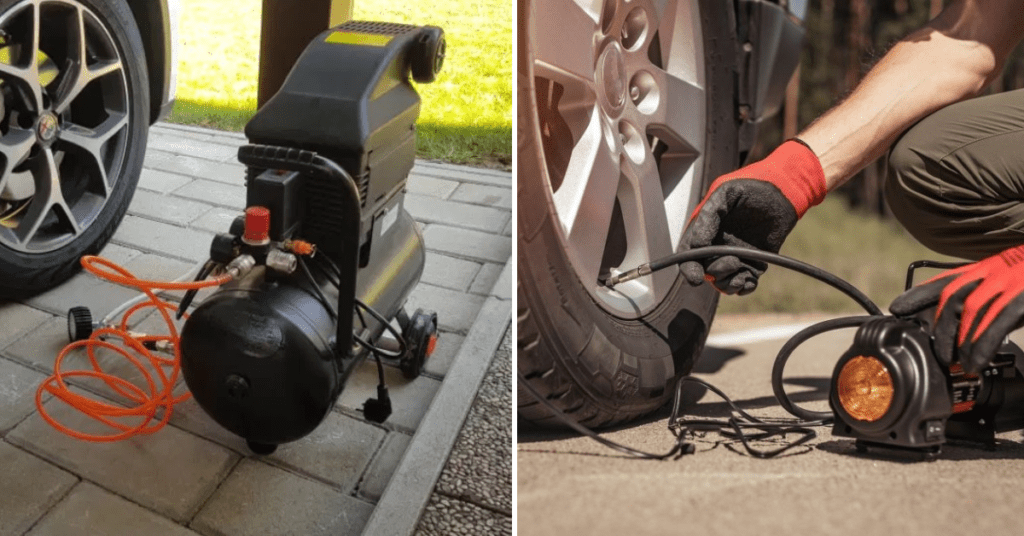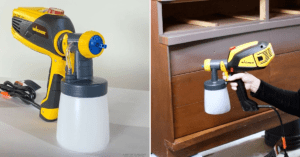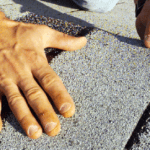How to Use Air Compressor for Tires
Are you having problems with flat tires? Or maybe you’re just looking to make sure your vehicle is always in the best condition. In either case, knowing how to properly use an air compressor for tires can come in handy. If you want to be proactive and maintain peak performance or have just been frustrated by a flat tire one too many times, understanding the basics of using an air compressor will set your mind at ease and prepare you for any future tire concerns. Keep reading for practical tips on how to safely and effectively use compressor technology when it comes to maintaining healthy car tires.

In this blog post, we will discuss how to use air compressor for tires properly and safely .From choosing the right type of air compressor for your car to following the simple step-by-step instructions on getting it connected, you’ll learn how easy it is to maintain adequate tire pressure with air compressors.
Types of Air Compressors for Tires
Before diving into the specifics of how to use an air compressor for tires, it’s important to understand the different types of air compressors available on the market. This knowledge will help you determine which type is best suited for your specific needs.
- Portable Air Compressors – These are smaller, compact units that can easily be transported from one location to another. They are ideal for inflation tasks, such as inflating car tires, sports equipment, and pool toys.
- Stationary Air Compressors – These larger units are typically mounted on a stable surface and can provide continuous air supply for extended periods. They are better suited for heavy-duty tasks like powering pneumatic tools or industrial applications.
- Pancake Air Compressors – These portable units have a flat, round shape resembling a pancake. They are lightweight and easy to store, making them perfect for small inflating tasks.
- Hot Dog Air Compressors – Similar to the pancake compressor, these units are also compact and great for smaller jobs around the house. The main difference is that they are cylindrical with a smaller, taller tank.
- Twin-Stack Air Compressors – These have two tanks stacked on top of each other, providing a higher air capacity and continuous flow. They are ideal for powering multiple tools at once or completing larger inflation tasks.
Choosing the Right Air Compressor for Tire Inflation
When it comes to choosing the right air compressor for your tire inflation needs, there are a few key factors to consider. The first is the type of tires you will be inflating – car tires, bike tires, or sports equipment. This will determine the necessary air pressure and flow rate required.
Next, think about portability and storage space. If you plan on using the air compressor for tasks other than just inflating tires, a portable unit may be more convenient. However, if you have limited storage space and only need to use it for tire inflation, a stationary or pancake compressor may be a better option.
It’s also important to consider the power source of the air compressor. Some models are electric-powered, while others run on gas or batteries. Depending on where you plan to use the compressor, one power source may be more practical than another.
Lastly, think about your budget and desired features. Some air compressors come with added features like digital displays, automatic shut-off, and built-in storage compartments for accessories. Set a budget and determine which features are most important to you before making a purchase.
Safety Precautions for Using an Air Compressor
Before using an air compressor for tire inflation, it’s important to take the necessary safety precautions. Here are a few tips to keep in mind:
- Always wear protective gear such as safety glasses and earplugs when operating an air compressor.
- Make sure the air compressor is placed on a stable surface to prevent tipping or movement during use.
- Never point the air hose at yourself or others, and keep it away from your face while inflating tires.
- Check the pressure gauge on the compressor to ensure it is set to the correct level for your tires. Over-inflation can cause tire blowouts, while under-inflation can decrease fuel efficiency and increase wear on tires.
- Keep an eye on the compressor’s temperature and shut it off if it starts to overheat.
Tools and Materials Needed
To properly use an air compressor for tire inflation, you will need the following tools and materials:
- An air compressor (of course!)
- Air hose with a pressure gauge
- Tire chuck or valve stem adapter to connect the air hose to your tire’s valve stem
- Pliers (if needed) to remove any valve stem caps or dust covers
- Tire pressure gauge (optional) for a backup reading
5 Easy Step-by-Step Guide to Using an Air Compressor for Tires
Step 1: Preparing the Air Compressor
- Make sure the compressor is turned off and unplugged before connecting any hoses.
- If using an electric-powered air compressor, make sure it is plugged into a grounded outlet with enough voltage to power the unit.
- For gas or battery-powered units, check that there is enough fuel or charge before starting.
Step 2: Preparing the Tire
- Park your car on a flat, stable surface and engage the parking brake.
- Remove the valve stem cap or dust cover from your tire’s valve stem and set it aside.
Step 3: Connecting the Air Hose
- Attach the air hose to the valve stem adapter or tire chuck. If using a tire pressure gauge, connect it to the other end of the hose.
- Securely attach the hose and make sure there are no leaks by pressing down on the fitting.
Step 4: Setting the Desired Pressure
- Turn on the air compressor and adjust the pressure setting to match the recommended pressure for your tires. This information can usually be found in your car’s manual or on a sticker inside the driver’s door.
- If using a tire pressure gauge, check the pressure reading on both the gauge and compressor to ensure they match.
Step 5: Inflating the Tire
- Hold the tire chuck or valve stem adapter firmly in place and turn on the air compressor.
- Monitor the pressure gauge to make sure the desired pressure is reached, and then turn off the compressor.
- Remove the hose from the valve stem and replace the cap or dust cover.
Congratulations, you have successfully inflated your tires using an air compressor.
Checking and Adjusting Tire Pressure
After using an air compressor to inflate your tires, it’s important to check the pressure again and make any necessary adjustments. Follow these steps:
- Remove the valve stem cap or dust cover from the tire.
- Use a tire pressure gauge to check the current pressure in the tire.
- If the pressure is lower than desired, use the air compressor to add more air until the correct pressure is reached. If it is higher, use the release valve on the compressor to let out air.
- Once the desired pressure is achieved, replace the valve stem cap or dust cover and check all other tires following the same steps.
By regularly checking and adjusting tire pressure with an air compressor, you can ensure a safe and smooth ride while also extending the life of your tires.
Pressure Guidelines for Different Tire Types
The recommended tire pressure for your vehicle can vary depending on the type of tires you have. Here are some general guidelines to follow:
- Standard car tires: 30-35 PSI
- High-performance or sports car tires: 40-50 PSI
- Bike tires: 40-65 PSI
Always refer to your specific tire manufacturer’s recommendations for the most accurate pressure guidelines.
Storing and Maintaining Your Air Compressor
Proper storage and maintenance of your air compressor can extend its lifespan and ensure optimal performance. Here are some tips to keep in mind:
- Store the compressor in a clean, dry area away from extreme temperatures.
- Regularly check for any leaks or damage to hoses or fittings before use.
- Properly drain all moisture from the air tank after each use.
- Clean the air filter regularly to prevent clogs.
- Refer to the manufacturer’s manual for specific maintenance and care instructions.
3 Tips for Maintaining Proper Tire Pressure
- Check your tire pressure at least once a month, and always before long trips.
- Keep an eye out for any visible damage or wear on tires that may affect their pressure.
- Avoid overloading your vehicle, as this can decrease tire pressure and cause uneven wear.
By following these tips and using an air compressor for tire inflation, you can ensure safe driving conditions and prolong the life of your tires.
Troubleshooting Common Issues
Even with proper usage and maintenance, you may encounter some issues when using an air compressor for tire inflation. Here are a few common problems and how to troubleshoot them:
- Leaking air hose: Check that the connection between the hose and valve stem or chuck is secure. If there is still a leak, it may be time to replace the hose.
- Overheating compressor: This can be caused by using the compressor for an extended period or not giving it enough time to cool down between uses. Allow the unit to cool before resuming use.
- Incorrect pressure reading: If your tire pressure gauge is showing a different reading than the air compressor, double-check that both are set to the same units of measurement.
If you encounter any other issues or are unsure about proper usage, refer to the manufacturer’s manual for troubleshooting tips or contact customer service.
FAQs on Using an Air Compressor for Tire Inflation
Can i use an air compressor to inflate other items besides tires?
Yes, an air compressor can also be used for inflating sports equipment, inflatable toys, and even some household items like air mattresses. Just make sure to adjust the pressure setting accordingly.
How often should i replace my tire’s valve stem caps or dust covers?
It’s a good idea to replace them whenever they become worn or damaged, as they help keep dirt and moisture out of the valve stem.
Can i use an air compressor to inflate a flat tire?
No, an air compressor is not meant for inflating completely flat tires. In this case, you should first use a spare tire or call for roadside assistance.
Can I use an air compressor in extreme temperatures?
It’s best to avoid using an air compressor in extremely cold or hot temperatures, as this can affect its performance. If necessary, store the compressor in a temperature-controlled environment before use.
Conclusion
As you can see, there is a lot to take into consideration when it comes to properly inflating your tires. To help make the process easier, be sure to purchase the right type of air compressor and familiarize yourself with its controls and safety features. Gather all the necessary tools and materials for the job and follow each step carefully for successful tire inflation! Finally, once the job is done, regulate tire pressure regularly according to guidelines and always store your air compressor securely with care. So now that you are up-to-speed on using an air compressor for tires, why not give it a go yourself? You’ll be glad you did! Happy and safe driving!






